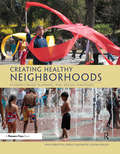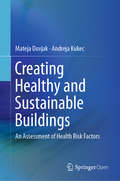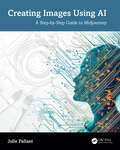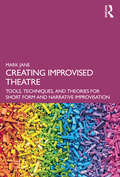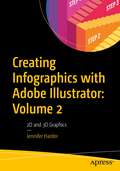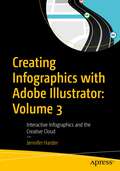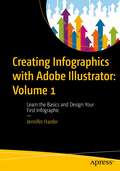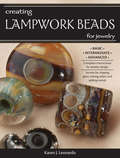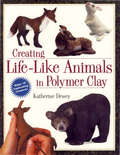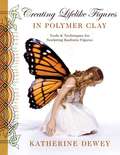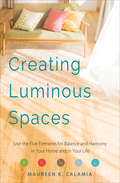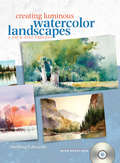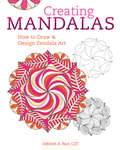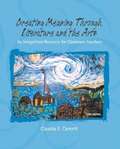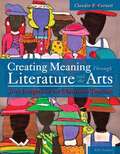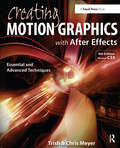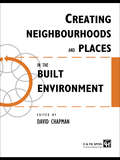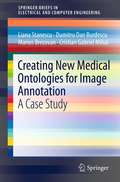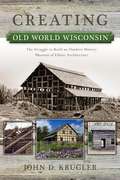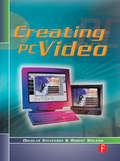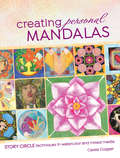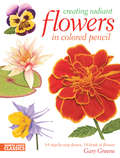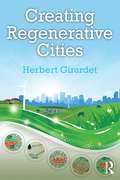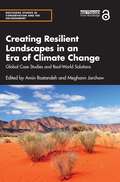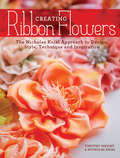- Table View
- List View
Creating Healthy Neighborhoods: Evidence-Based Planning and Design Strategies
by Ann Forsyth Emily Salomon Laura SmeadGood housing. Easy transit. Food access. Green spaces. Gathering places. Everybody wants to live in a healthy neighborhood. Bridging the gap between research and practice, it maps out ways for cities and towns to help their residents thrive in placed designed for living well, approaching health from every side – physical mental, and social.
Creating Healthy and Sustainable Buildings: An Assessment of Health Risk Factors
by Mateja Dovjak Andreja KukecThe open access book discusses human health and wellbeing within the context of built environments. It provides a comprehensive overview of relevant sources of literature and user complaints that clearly demonstrate the consequences of lack of attention to health in current building design and planning. Current designing of energy-efficient buildings is mainly focused on looking at energy problems and not on addressing health. Therefore, even green buildings that place environmental aspects above health issues can be uncomfortable and unhealthy, and can lead to public health problems. The authors identify many health risk factors and their parameters, and the interactions among risk factors and building design elements. They point to the need for public health specialists, engineers and planners to come together and review built environments for human wellbeing and environmental sustainability. The authors therefore present a tool for holistic decision-making processes, leading to short- and long-term benefits for people and their environment.
Creating Images Using AI: A Step-by-Step Guide to Midjourney
by Julie PallantCreating Images Using AI: A Step-by-Step Guide to Midjourney is an essential resource for professionals and others looking to harness the amazing power of AI-powered image generator programs and to ensure they keep up to date with developments in this rapidly evolving field. This comprehensive guide offers an in-depth exploration of Midjourney, one of the most respected programs available today, used by over 17 million users.The book covers the fundamentals of setting up and using Midjourney through to advanced techniques for crafting precise text- and image-based prompts to ensure high-quality images. Detailed step-by-step instructions are provided to facilitate a thorough understanding of the program, supported throughout by screenshots and examples of Midjourney image output. Included are case studies of talented artists who use Midjourney as a creative tool, with examples of their inspiring art to motivate readers. A dedicated chapter offers resources for photographers, designers, and artists to expand their skills, and to stay up to date with the latest developments in AI technology.Whether you're seeking to enhance your professional toolkit or simply explore AI as a creative outlet, this book offers the knowledge and skills to harness Midjourney’s full potential. For professionals in photography, graphic design, marketing, advertising, and education, it provides the essential tools to stay ahead in a rapidly changing industry.
Creating Improvised Theatre: Tools, Techniques, and Theories for Short Form and Narrative Improvisation
by Mark JaneCreating Improvised Theatre: Tools, Techniques, and Theories for Short Form and Narrative Improvisation is a complete guide to improvised theatre for performers and instructors. This book provides a modern view of improvised theatre based on the rapid evolution of this art form, shedding new light on classic theories as well as developing lesser known and emerging techniques, such as the Trance Mask. Instead of simply referencing classic theories, the book revisits them and places them in the context of contemporary improvisation techniques. Designed as a practical support, this guide contains over 130 exercises that allow its theories to come alive in workshops, rehearsals, and performance. The book is divided into four sections: Nuts and bolts: The fundamental tools of improvisation to explore how to be spontaneously creative, build with your partner, and learn from masks to discover your scene instant by instant. Short form: Techniques for scene work and short form performance, including how to get the most out of a scene, remain connected to the relational stakes, provoke change (physical, status, and emotional), and maintain a playful attitude. Narrative improvisation: Theories to help navigate long form narrative-based shows with "narrative waypoints," generate variety, develop protagonists, work on genres, and manipulate creative transitions. The bits box: Advice for warming-up before a rehearsal or a show with a collection of useful games. Written to inspire creativity and provide the tools to develop innovative improvised shows and experiences, Creating Improvised Theatre is an invaluable source book for anyone interested in the art of improvised theatre, whether a beginning student or experienced performer.
Creating Infographics with Adobe Illustrator: 2D and 3D Graphics
by Jennifer HarderThis full-color book will teach you how to use Adobe Illustrator's various tools to create infographics, as well as basic page layouts for them. It focuses on Illustrator’s powerful graphing tools and 2D and 3D effects. How can an infographic or graph be altered and adapted to appear more engaging and still display your data accurately? What additional effects can be used on your infographic to produce the results you envision? In this second volume of Creating Infographics with Adobe Illustrator, you will learn the answers to all these questions. Author Jennifer Harder will walk you through creating basic infographics in Illustrator using Illustrator tools such as Graphing Tools as well as how to create 2D effects and 3D shapes with their related materials, including Symbols. Upon completing this volume, you will have an appreciation for how easy it is to design an infographic or graph to display your data and discover how rudimentary shapes and colors can be altered using patterns, as well as 2D and 3D effects, to enhance readability while conveying meaning to your audience. You will be able to use this knowledge to create your own infographics using Illustrator’s wide array of tools. What You Will Learn Use Illustrator’s Graphing Tools to create and modify basic charts or graphsWork with popular 2D effects to enhance your design in IllustratorCreate 3D Shapes using Materials and Symbols and modify your 3D GraphsExplore basic Image Trace and Perspective options in Illustrator Who This Book Is For Beginner-level designers and others who are interested in learning the process of creating infographics for their company, the classroom, for data visualization, an article in a magazine, or a webpage.
Creating Infographics with Adobe Illustrator: Interactive Infographics and the Creative Cloud
by Jennifer HarderThis full-color book, the third of three volumes, focuses on Adobe Illustrator’s SVG interactivity tools. How can an infographic be made more interactive for an audience? What additional Illustrator tools and Adobe applications can be used to enhance your infographic layout? In this final volume of Creating Infographics with Adobe Illustrator, you will learn the answers to all these questions. Author Jennifer Harder will walk you through creating basic infographics in Illustrator using Illustrator tools for creating SVG files, known as Scalable Vector Graphics, for basic Interactivity on a web page. Then you will review layouts in other Adobe Applications in relation to their connectivity with Illustrator. Upon completing this volume, you will have a thorough understanding of how to design an infographic with basic interactivity for a web page, and how this can improve visualization and convey meaning to your audience. Moreover, you will be able to use this knowledge to create your own infographics using Illustrator’s wide array of tools. What You Will Learn Discover how to apply interactivity to an infographicGain insight into different infographic layouts and how to finalize your project with your clientExplore other Adobe Creative Cloud applications that may assist you in the future as you create your infographics Who This Book Is For Beginner-level designers and others who are interested in learning the process of creating infographics for their company, the classroom, for, an article in a magazine, or adding interactivity to webpage.
Creating Infographics with Adobe Illustrator: Learn the Basics and Design Your First Infographic
by Jennifer HarderThis full-color book will teach you how to use Adobe Illustrator's various tools to create infographics, as well as basic page layouts for them. This is the first of three volumes which will cover all the fundamentals of Illustrator, an industry standard application used by graphic designers and marketing and communication teams. How is an infographic different from a logo or any other illustration? What additional thought processes, skills, or software tools should be utilized to create an infographic? In this first volume of Illustrator Basics, you will learn the answers to all these questions. Author Jennifer Harder will walk you through creating basic infographics in Illustrator using Basic Shape tools, Pen Tools, Type Tools, and Symbols. Upon completing this volume, you will have an appreciation for how easy it is to design an infographic and discover how rudimentary shapes and colors can affect readability while conveying meaning to your audience. You will be able to use this knowledge to create your own infographics using Illustrator’s wide array of tools. Who This Book Is For Discover the tools within Illustrator that are ideal for creating basic infographicsDevelop a logo based upon a scanned sketchGain an understanding of different infographic layouts and the process of reviewing them with your client Who This Book Is For Beginner-level designers and others who are interested in learning the process of creating infographics for their company, the classroom, for a visual resume, an article in a magazine, or a webpage.
Creating Lampwork Beads for Jewelry
by Karen LeonardoCREATE - DESIGN - WEAR From tiny glass beads and pendants to rings and necklaces, Creating Lampwork Beads for Jewelry teaches you how to create them all. Lampwork artist Karen J. Leonardo and her network of fellow artisans share their secrets for creating stunningly beautiful lampwork beads. In addition, these talented artists give you complete instructions for incorporating the beads into your own artistic jewelry pieces. Ideal for beginning, intermediate and advanced lampwork artists, Creating Lampwork Beads for Jewelry features: Guidance and tips for setting up your studio and selecting the proper tools Detailed instructions with step-by-step photos for creating 16 different lampwork beads 14 jewelry designs to incorporate your beads into necklaces, bracelets, rings, earrings and pins
Creating Life-Like Animals in Polymer Clay
by Katherine DeweyEnchanting, exquisitely detailed and full of personality, Katherine Dewey's animal sculptures delight all who see them. With the friendly medium of polymer clay and the step-by-step instructions in this book, you can achieve the same magical results! Inside, Katherine leads you through then utterly charming projects, such as a sweet little bluebird, a basset hound and a white-tailed fawn. And that's just the start! The "Making Changes" chapter will help you create your own original animal creations by changing poses, making realistic bases, and even modeling your animals to look like bronze, fade and other materials.
Creating Lifelike Figures in Polymer Clay: Tools and Techniques for Sculpting Realistic Figures
by Katherine DeweyKatherine Dewey's expressive and elegantly detailed sculptures enchant all who see them. With the magical medium of polymer clay and this book, you can follow in her footsteps.Thorough instructions supported by more than 400 step-by-step color photos and 200 detailed drawings cover the entire process of sculpting realistic figures, from selecting clay and gathering essential tools to the basics of modeling the human figure, to incorporating poses, facial expressions, ethnic and gender subtleties, costumes, and painted finishing touches. Easy-to-read maps of the figure illustrate the landmarks of the body, while scale diagrams indicate the simple shapes hidden within the human form, as well as how to combine and model those shapes.For anyone who loves fantasy, romance, nature--or sophisticated crafting--this book is a must-have.
Creating Luminous Spaces: Use the Five Elements for Balance and Harmony in Your Home and in Your Life
by Maureen K. CalamiaAncient and global modern design come together in this practical guide to interior design, biophilic design, and feng shui for your home. Part spiritual growth workbook and part treatise on the power of nature, Creating Luminous Spaces is your practical guide to giving your home a refreshing energy boost. In this inventive approach to interior design, Maureen K. Calamia blends modern trends with the five elements of feng shui, an ancient Chinese system that brings the cycles and benefits of nature to your home interior. With inspiring ideas and practical information, Calamia will help you discover which of nature&’s elements represents your energy. Should you enhance your home with natural light or a fish bowl? New organizational habits or tall, vertical lines? Featuring practical exercises, meditations, and real stories about clients and students, as you embark on this mind-body-spirit connection with your home, you&’ll find out how: Indoor lighting and lighting design can strengthen the fire elementOrganizational behavior is influenced by the metal elementSpace planning with plants nourishes the wood elementAnd more!
Creating Luminous Watercolor Landscapes
by Sterling EdwardsHow to paint your world in watercolor...and have fun doing it! The day Sterling Edwards watched an artist paint an entire sky with three deft brushstrokes was the day he committed to trading his tiny oil brushes and photorealistic style in favor of big, bold strokes of watercolor. In the years since, he's developed not only a wonderfully fresh, luminous painting style, but also an approach that takes the intimidation out of this beautiful but often-mystifying medium. In this book, he shares both. Initial chapters lay the foundation for successful paintings, from choosing the right brushes to achieving vibrant colors, interesting textures and strong compositions. Step-by-step demonstrations illustrate techniques for painting rocks, skies, trees, foliage, buildings, water and other landscape elements. An easy-to-follow, four-step painting process makes for easier starts and stronger finishes, complete with rich darks and sparkling highlights. Eight complete painting projects cover a range of breathtaking scenes and seasons. Whether you're dipping into the medium for the first time or you're a watercolor devotee on a quest for clearer color and more personal statements, this book will help you make the most of the time you spend with brush in hand.
Creating Mandalas: How to Draw and Design Zendala Art
by Deborah PacéMASTER THE ART OF MAKING MANDALAS!The art of making mandalas and zendalas is less about drawing and more about slowing down and opening up to your inner creative flow. You do not have to be an artist. There is no need to know how to draw. All you need are some simple everyday tools and a little effort. Can you create a circle using a compass and pencil? Can you draw a line? Can you repeat patterns? Then YOU can create your own mandalas and zendalas!Get inspired with more than 40 project ideas, step-by-step demonstrations, templates and gallery pieces.Whether you prefer to plan or would rather go with the flow, practice pages throughout the book make it easy to get started.Find tips for adding Zentangle patterns, coloring, drawing on colored paper, with stencils, and creating gold-leafed, Spirograph-inspired and snowflake mandalas.Discover your style, whether it be structured, freeform, bold and dramatic, or whimsical, and learn to design, draw and color your own original works of mandala and zendala art. Simply breathe, reach for your pencil and begin.
Creating Meaning Through Literature and the Arts: An Integration Resource for Classroom Teachers (Third Edition)
by Claudia E. CornettThe most comprehensive text on arts integration in the market, this bestseller redefines literacy in light of the 21st century need for multiple literacies. It provides an overview of academically linked research in five arts areas: literary arts, visual art, drama, dance, and music, and is intended as a complete introduction to how to meaningfully use the arts as teaching tools on a daily basis in every curricular area. Organized around WHAT, WHY and HOW questions, Creating Meaning through Literature and the Arts, 5/e tells the story of how arts integration (AI) has grown so much in a few decades using the story of hundreds of arts-based schools–old and new, public, magnet, and charter, today’s. Each AI school story draws upon cutting edge research, evolving state standards, and constructivist beliefs to transform teaching and learning. The Enhanced Pearson eText features video resources.
Creating Meaning Through Literature and the Arts: Arts Integration for Classroom Teachers
by Claudia E. CornettThe most comprehensive text on arts integration in the market, this bestseller redefines literacy in light of the 21st century need for multiple literacies. It provides an overview of academically linked research in five arts areas: literary arts, visual art, drama, dance, and music, and is intended as a complete introduction to how to meaningfully use the arts as teaching tools on a daily basis in every curricular area. Organized around WHAT, WHY and HOW questions, Creating Meaning through Literature and the Arts, 5/e tells the story of how arts integration (AI) has grown so much in a few decades using the story of hundreds of arts-based schools–old and new, public, magnet, and charter, today’s. Each AI school story draws upon cutting edge research, evolving state standards, and constructivist beliefs to transform teaching and learning.
Creating Motion Graphics with After Effects: Essential and Advanced Techniques (Dves/dv Expert Ser.)
by Chris Meyer Trish MeyerTrish and Chris Meyer share over 17 years of hard-earned, real-world film and video production experience inside this critically acclaimed text. More than a step-by-step review of the features in AE, readers will learn how the program thinks so that they can realize their own visions more quickly and efficiently. This full-color book is packed with tips, gotchas, and sage advice that will help users thrive no matter what projects they might encounter. Creating Motion Graphics 5th Edition has been thoroughly revised to reflect the new features introduced in both After Effects CS4 and CS5. New chapters cover the revolutionary new Roto Brush feature, as well as mocha and mocha shape. The 3D section has been expanded to include working with 3D effects such as Digieffects FreeForm plus workflows including Adobe Repoussé, Vanishing Point Exchange, and 3D model import using Adobe Photoshop Extended. The print version is also accompanied by a DVD that contains project files and source materials for all the techniques demonstrated in the book, as well as nearly 200 pages of bonus chapters on subjects such as expressions, scripting, and effects. Subjects include: Animation Techniques; Layer Management; Modes, Masks, and Mattes; Mastering 3D Space; Text Animation; Effects & Presets; Painting and Rotoscoping; Parenting, Nesting, and Collapsing; Color Management and Video Essentials; Motion Tracking and Keying; Working with Audio; Integrating with 3D Applications; Puppet Tools; Expressions; Exporting and Rendering; and much more.
Creating Neighbourhoods and Places in the Built Environment (Built Environment Series Of Textbooks Ser.)
by David ChapmanThis design primer examines the forces at work in the built environment and their impact on the form of buildings and their environments. The actions of a range of individuals and agencies and the interaction between them is examined, exploring the competing interests which exist, their interaction with physical and environmental forces and the uncertain results of both individual and corporate intervention.
Creating New Medical Ontologies for Image Annotation: A Case Study (SpringerBriefs in Electrical and Computer Engineering)
by Liana Stanescu Dumitru Dan Burdescu Marius Brezovan Cristian Gabriel MihaiCreating New Medical Ontologies for Image Annotation focuses on the problem of the medical images automatic annotation process, which is solved in an original manner by the authors. All the steps of this process are described in detail with algorithms, experiments and results. The original algorithms proposed by authors are compared with other efficient similar algorithms. In addition, the authors treat the problem of creating ontologies in an automatic way, starting from Medical Subject Headings (MESH). They have presented some efficient and relevant annotation models and also the basics of the annotation model used by the proposed system: Cross Media Relevance Models. Based on a text query the system will retrieve the images that contain objects described by the keywords.
Creating Old World Wisconsin
by John D. KruglerWith its charming heirloom gardens, historic livestock breeds, and faithfully recreated farmsteads and villages that span nearly 600 acres, Old World Wisconsin is the largest outdoor museum of rural life in the United States. But this seemingly time-frozen landscape of rustic outbuildings and rolling wooded hills did not effortlessly spring into existence, as John D. Krugler shows in Creating Old World Wisconsin. As dozens of historic buildings were transported in the 1970s from various locations throughout the state to the Kettle Moraine State Forest, researchers, curators, and volunteers launched a massive preservation initiative to salvage fast-disappearing immigrant and migrant architecture. They created a backdrop against which twenty-first-century interpreters demonstrate nineteenth- and early twentieth-century agricultural techniques and artisanal craftsmanship. The site, created and maintained by the Wisconsin Historical Society, offers visitors a unique opportunity to learn about the states rich and ethnically diverse past through depictions of the everyday lives of its Norwegian, Danish, Finnish, German, Polish, African American, and Yankee inhabitants. Creating Old World Wisconsin chronicles the fascinating and complex origins of this outdoor museum, highlighting the struggles that faced its creators as they worked to achieve their vision. Even as Milwaukee architect and preservationist Richard W. E. Perrin, the Societys staff, and enthusiastic volunteers opened the museum in time for the national bicentennial in 1976, the site was plagued by limited funds, bureaucratic tangles, and problems associated with gaining public support. By documenting the engaging story of the challenges, roadblocks, false starts, and achievements of the sites founders, Krugler brings to life the history of the dedicated corps who collected and preserved Wisconsins diverse social history and heritage.
Creating PC Video
by Douglas Stevenson Robert WolenikThis book teaches readers how to put a working system together by showing them the equipment available to them, and what it can do. Readers will learn how to create video products using the computer as an editing tool, and how to refine sound and combine graphics with video. Information on web distribution is included. With the advent of the new digital camcorders developed by Panasonic and Sony in the new DV format, professional quality video is available in consumer-level equipment. At the same time, digital editing is now available for the PC using video capture cards in the $500-$1,000 price range, and digital editing software in the $800-$1,200 range, such as Adobe Premiere. This combination enables users such as the sophisticated amateur video maker, the wedding or business presentation video maker, and people working in multimedia for educational, training, or other presentation purposes, to edit their own work and turn out competent professional-quality video.
Creating Personal Mandalas: Story Circle Techniques in Watercolor and Mixed Media
by Cassia CoggerRelax your spirit and reconnect to your authentic voice. Discover the simple magic and mystery that awaits you when you express yourself within the safe space of a circle. In Creating Personal Mandalas, you'll see how this most basic of shapes can open your heart and always leads you back to your center. In each of the 10 chapters, you'll explore two soul-expressing mandala exercises, facts and history on featured symbols, insights for using the confines of the circle for personal and visual storytelling, as well as inspiring art and reflections from contributing guest artists.20 exploratory step-by-step mandala exercises--each an opportunity for new self-exploration, beginning with tips on establishing the right mindsetInteresting facts about symbols and sacred geometry, including suggestions for using them in your mandala projectsPractical art-making direction on the elements of design, watercolor tips, composition prompts, seeing color as a storytelling element and moreUse Creating Personal Mandalas to start expressing your life stories with the infinite possibilities of the circle.
Creating Radiant Flowers in Colored Pencil: 64 step-by-step demos / 54 kinds of flowers
by Gary GreeneMaster the Secret of Creating Spectacular Flowers in Colored Pencil When it comes to choosing a subject, flowers are a perennial favorite for artists because of their exciting variety and complexity of color, texture and details. It's amazing, then, that their vibrant natures can be captured so realistically with the simple and direct medium of colored pencil. The "secret" is making the most of colored pencil's distinctive translucent properties with techniques such as layering, burnishing and underpainting. Gary Greene--along with six other respected colored pencil artists--shows you how in 64 step-by-step demonstrations. Arranged from azalea to zinnia for easy reference, these demonstrations detail the methods and specific colors for creating a variety of flowers, including: anthurium * amaryllis * aster * begonia * bird of paradise * cactus flower * calla lily * camellia * carnation * chrysanthemum * cineraria * crocus * columbine * daffodil * dahlia * Easter cactus * foxglove * fuchsia * geranium * Gerbera daisy * gladiolus * hibiscus * hydrangea * hyacinth * iris * lily * lupine * magnolia * marigold * nasturtium * passion flower * peony * petunia * poinsettia * poppy * primrose * rhododendron * slipperwort * snapdragon * sunflower * trillium * tulip * water lily Complete with advice on the best tools and reference materials, this unique guide helps you capture the beauty of flowers in colored pencil.
Creating Regenerative Cities
by Herbert GirardetLarge, modern cities have effectively declared their independence from nature. But while they take up only three percent of the world’s land surface, their ecological footprints actually cover the entire globe. Humanity is building an urban future, yet urban resource use is threatening the future of humanity and the natural world. To meet the aspirations of city people in both developing and developed countries, bold new initiatives are needed. Modern cities are an astonishing human achievement. As centres of innovation they are humanity’s cultural playgrounds. Their communication and transport systems have developed a global reach. They are attractive to investors because they can offer a vast variety of services at comparatively low per-capita costs. But are they viable as ecological systems? The planning of new cities, as well as the retrofit of existing cities, needs to undergo a profound paradigm shift. Mere 'sustainable development' is not enough. To be compatible with natural systems, cities need to move away from linear systems of resource use and learn to operate as closed-loop, circular systems. To ensure their long-term future, they need to develop an environmentally enhancing, restorative relationship between themselves and the natural systems on which they still depend. Creating Regenerative Cities is a concise, solution-oriented manual for creating regenerative urbanisation. A wide range of technical, management and policy solutions already exist, but implementation has been too slow and too little, in large part because the kinds of holistic approaches needed are still unfamiliar to fragmented and process-driven urban policy making and governance. Herbert Girardet's 30 years’ experience as an ecologist, thinker, film maker and consultant working around the world has created this unique combination of tried and tested best practices and policies, which outlines the fundamental shifts needed in the way we think about our cities.
Creating Resilient Landscapes in an Era of Climate Change: Global Case Studies and Real-World Solutions (Routledge Studies in Conservation and the Environment)
by Amin Rastandeh Meghann JarchowThis book delivers a realistic and feasible framework for creating resilient landscapes in an era of anthropogenic climate change. From across six continents, this book presents fifteen case studies of differing sociocultural, economic, and biophysical backgrounds that showcase opportunities and limitations for creating resilient landscapes throughout the world. The potential to create socio-ecological resilience is examined across a wide range of landscapes, including agricultural, island, forest, coastal, and urban landscapes, across sixteen countries: Argentina, Australia, Brazil, Denmark, Finland, Greece, Guatemala, Japan, Mexico, Norway, Samoa, South Africa, the United States, Turkey, Uruguay, and Vanuatu. Chapters discuss current and future issues around creating a sustainable food system, conserving biodiversity, and climate change adaptation and resilience, with green infrastructure, nature-based architecture, green-tech, and ecosystem services as just a few of the approaches discussed. The book emphasizes solution-oriented approaches for an "ecological hope" that can support landscape resiliency in this chaotic era, and the chapters consider the importance of envisioning an unpredictable future with numerous uncertainties. In this context, the key focus is on how we all can tackle the intertwined impacts of climate change, biodiversity loss, and large-scale land-cover conversion in urban and non-urban landscapes, with particular attention to the concept of landscape resiliency. The volume provides that much-needed link between theory and practice to deliver forward-thinking, practical solutions. This book will be of great interest to students, researchers, practitioners and policymakers who are interested in the complex relationship between landscapes, climate change, biodiversity loss, and land-based conversion at local, national and global scales.
Creating Ribbon Flowers: The Nicholas Kniel Approach to Design, Style, Technique & Inspiration
by Nicholas Kniel Timothy WrightMaster the art of ribbon flowers! Nicholas Kniel and Timothy Wright teach their method of creating gorgeous ribbon flowers in this collection of illustrated, step-by-step lessons. With only a few yards of ribbon, you can make the perfect embellishment for any garment, home decor item, wedding party and more. 33 flowers provide a wide range of options for any craft or sewing project. 9 project ideas inspire you to create popular ribbon flower items, such as corsages, boutonnieres, French bulletin boards, bouquets and hair pins, or to design your very own creations. 10 techniques describe how to prepare ribbons for use and how to finish the final flower with clips, pins and stems.
